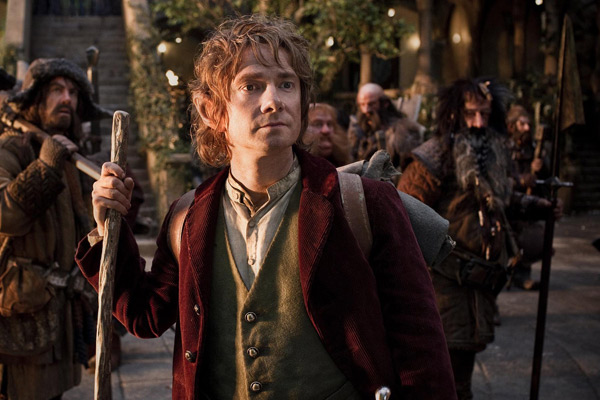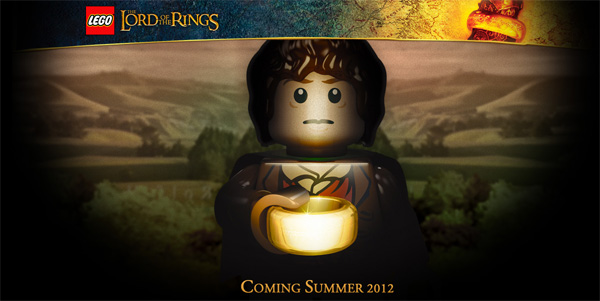
 Within the past couple of days, people have been slamming The Hobbit film. Not for the content, though, they seem to love that. They’ve been talking about the speed at which the film is displayed: 48 FPS. Until now, that hasn’t been possible to display at a movie theater. Until now, and for the last 90 years, all movies have been projected at a mere 24 frames per second.
Within the past couple of days, people have been slamming The Hobbit film. Not for the content, though, they seem to love that. They’ve been talking about the speed at which the film is displayed: 48 FPS. Until now, that hasn’t been possible to display at a movie theater. Until now, and for the last 90 years, all movies have been projected at a mere 24 frames per second.
It’s a leap forward in technology.
Something weird is happening, though. The negative reaction to the 48 FPS is because it is “too realistic.” But since when has that been a problem for people? People to want their video game graphics to be as realistic as possible. I’m one that doesn’t care what the game looks like, as long as it’s fun to play. I love a beautiful looking video game, but I think that the SNES and up is fine as far as graphics quality. But more often than not, people talk about how great the graphics look, and that’s what they’re looking for in a video game. People also buy the latest and greatest in HD TVs, Blu-ray Discs, and even Apple is touting the graphical display capabilities of the new iPad (3rd Generation).
And when our movies look better, we’re suddenly against it?
“Indeed, the footage was vivid, with grass blades, facial lines and soaring mountains appearing luminous and pronounced. The actors looked almost touchable, as if they were performing live on stage.” (CBS)
That sounds FANTASTIC to me. I want to see that. That sounds magical. That sounds like what movies should be. Completely immersive.
Now, an article in Variety sheds a very positive light on it:
Ten days before the “Hobbit” footage debuted, James Cameron told me about the high-frame-rate (HFR) look, “I think there will be people that love it. And there will be people that say it looks like video, because video is the only way they can process something that looks too real. But it’s really quite magical.”
It goes on from there, but here’s another highlight:
First, HFR solves a couple of problems, especially for 3D. At 24 fps, when the camera pans or an object moves quickly across the screen, the image smears with “judder” or “strobing,” which is annoying in 2D but infuriating in 3D. Higher frame rates reduce or banish strobing.
Higher frame rates also let projection get brighter. With brighter light comes more flicker. If the frame rate goes up, flicker goes down, so brightness can go up, too.
In fact, movies would flicker at even today’s standard light levels, but each frame is flashed two or three times, depending on the projector, to prevent flicker. So in that sense, projectors have been delivering a sort of ersatz version of HFR (48 or 72 fps) all along.
But frame rates do change the look of the picture radically. While movies were at 24, standard-def TV was 30 frames per second. The difference between 24 and 30 may not sound like a lot, but it is.
During the High Frame Rates panel at the recent SMPTE Summit on Cinema, Northrop Grumman Aerospace’s Stephen Long took to a microphone to discuss research his company had done on frame rates a decade ago.
“We learned very quickly that the ‘film look’ was all about 24 (fps), it’s not about film,” Long said. “As soon as we rotated the variable speed to 30 it looked like television. When we cranked it up above 50, it started to look different than anything.”
Long’s team found a “jump” at around 54-60 fps.
“Wow, something changed,” he said. “It looked better. That’s not a scientific description. It changed the perception, the sense of reality.”
Now, you might be looking at this and thinking that it’s weird that The Hobbit is shooting in 48 FPS and not 60 FPS, then. There’s actually a good reason for that, and it’s not just something Peter Jackson said. He did say that the leap between 24 and 48 was incredible but 48 to 60 FPS wasn’t that great a difference. However, it seems that technology also had something to do with that decision.
Asked why “The Hobbit” is being made at 48 instead of 60, which seems to be “better,” Phil Oatley, head of technology for Park Road Post, said “Because we can’t show it (60) yet. … It came down to how can we get a high frame rate film made by the end of the year?”
That’s why I don’t think 48 fps is going to be the new standard: It’s an only an interim step.
HDTVs are already capable of 60 fps or more, and some broadcasts use a version of 60 fps. In fact, TV is the elephant in the room in this conversation, because it’s pushing the entertainment world toward 60 fps.
Cool, so when the Hobbit comes out on Blu-ray, I’ll be able to watch it as Peter Jackson intended on my TV at home… in 48 FPS video. That is a very good thing.
People want better graphics in their video games, they want HD TVs and they want Blu-ray Discs and High Def streaming, and they want HD iPads, and even Apple markets it as more magical and more incredible… and yet our movies can’t ever get better?




I think in one sense I agree with the opponents of higher frame rate. As an photographer, film has a distinctive look all its own, one that has yet to be completely grasped in digital… video has an even bigger gap away from film once you add motion into the picture, and I don’t particularly like the ‘TV’ look, unless well I’m watching TV, in which case most TVs that now do 24p are way to jumpy for my eyes… at the same time I’m actually more interested in seeing the hobbit because of this, the fact that It’s not 30p but something else is encouraging. However I think a balance will need to be achieved in the future as technology pushes the limits of what we CAN do, true artists need to be the balance to say I want my video to have the old film look, or the old TV look, or the video game look etc…
Digital vs. Film is actually a separate issue to 24 vs. 48 frames per second. Digital does allow us to actually do 48 frames per second, where film will never be able to. Running film through a projector that fast actually tears the film to shreds. Yeah, it’s going to be an artistic decision, that I know, but digital is improving so much all the time, that we’re matching or beating the image quality of optical, or will be soon.
I have a flat screen that digitally smooths things, and it makes evrything so clear…I hate it! I mean I can’t stand it so much that Id rather watch nothing than that tv with the feature turned on. I think it looks a lot like a play being acted right in front of me, but I come to find out that a lot of work goes into editing video in way that draws focus to certain things, and if everything is crystal clear I tend to miss things that directors and producers intended for me to see. I am not sure if 48 fps is anything like this but if it was Id probably walk out of the theater… sounds crazy, but I guess I kno what the uproar is about if its anything like my tv.
I think I know what you’re talking about. I have a TV that can do the same. I never use it. However, I have a couple of friends that showed me scenes from Captain America with that feature turned on, and with it turned off. I could not tell you what they saw that was so bad, but I could not tell the difference. When I watch something I want it to look as real as possible. My friend David said the same thing you did… that he felt like it was being acted out right in front of him…
I have two thoughts on that: 1) Aren’t movies supposed to look realistic? When we complain that an effect looks fake, and then complain about something being too realistic, we can’t have it both ways. It’s either going to look hyper-real or fake. There’s no in-between. 2) When they were showing me the same scene in both the high speed whatever, and the normal, they were saying “see?” and I couldn’t tell what I was supposed to be looking for. Both looked absolutely identical to me. What should I look for?
Secondly… a film shot at 24FPS and artificially made to run faster by the technology in your television is not the same thing as a film shot in 48FPS. This is because your TV can not really know what else would be in the middle frame. The best it can do is guess.
I know that directors intend for you to see certain things at certain times, but a good director can do that with proper scene framing.
Hey the better and more real they can make it look the better. You want the screen to really pop out at you it adds to the atmosphere of whatever you’re watching.
To me a clearer picture on a big screen be it cinema or at home on the tv is the way forward
Agreed! Having seen it at 48 FPS, I have to say, the clarity added to my viewing experience. I anticipate it will only get better.
Are you sure that the blu ray will support watching the 48 fps version at home? I loved the HFR version and could never go back to 24FPS. If the blu-ray will support 48fps then I will be sure to get the blu-ray now, otherwise I will wait for home video technology to be capable of playing the hfr version.
When I wrote this, I had just thought that technology like Blu-ray was capable of 48FPS playback. Unfortunately, that’s not the case. Apparently it could take a firmware upgrade to be able to do that. I don’t know if/when that’ll happen. I have heard rumor of a new Blu-ray format called Blu-ray 4K that might be coming soon. However, I do believe current Blu-ray is perfectly capable of displaying 48FPS video, but according to Wikipedia (lol) it’s not going to be without some sort of upgrade.